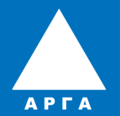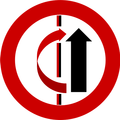Road signs in Greece
Road signs in Greece, are regulated by the Ministry of Transport and the Hellenic Traffic Police, according to the Greek Highway Code.
Signs follow the general European conventions concerning the use of shape and colour, for every sign category. Signs indicating dangers are triangular with a red border, those giving orders are almost all circular (white on blue for mandatory instructions, black on white with a red border for prohibitions), and those providing information are rectangular. Most signs use pictograms to convey their particular meaning.
As is customary in European countries, all signs are partly or fully reflectorized or are provided with their own night-time illumination. Signs used for temporary regulations may have a yellow background colour.
Greek road signs depict people with realistic (as opposed to stylized) silhouettes. Also, all signs are identified by a Greece capital letter (for each category) and a number. Signs that indicate the same meaning but in a different direction have the same letter and number but are separated by a lowercase (eg, α, β, γ, δ, ... or α for left and δ for right)
History
_from_the_Roman_road_that_ran_through_Boeotia._2nd_cent._B.C.jpg)
The history of road signaling in Greece dates back to Antiquity. The first road signaling included marble columns with the head of Hermes, protector of the wayfarers. Those signs were known known as "ἑρμαῖ" ("Hermai").[1] There were also milestones for measuring street length in stadions.[2] Similar columns were also used in Roman times, but had miles as a unit of measurement. Shortly after Greece's independence in 1836, an order was issued to place the first road signs in Greece. They were stone carved signs with distances between cities according to the metric system that was in force at the time.[3]
The first road signage on Greek roads with contemporary signs was made in 1924 by ELPA (Elliniki Leschi Periigiseon kai Aftokinitou, lit. translated: Hellenic Club of Tours and Car), [4] which took over the road network's signage until 1957, when it was taken over by the state. [5] The signs were subject to the provisions of the Geneva Protocol on Road Signs and Signals.
On July 25, 1962, and with Government Gazette A '110/62, it was announced in paragraph 1 of Article 14 that "by joint decisions, issued by the Ministers of Transport, Public Works and Interior, all matters relating to the road signs, roadmarkings, the type of signals, the characteristics of the road signage and the manner of its application shall be defined. ", while in paragraph 2 of the same article that "the provisions of the International Geneva Protocol on Road Signs and Signals of September 1949, with its supplements, are temporarily valid and up-to the apply of the referenced of the paragraph 1 of this Article. "
Finally, on July 6, 1974, 12 years after the initial announcements and with the Government Gazette B '676/74, the first serious signaling standards were established, which are still valid today.[6] It was the first time that sign diagrams were included in a Government Gazette. Since the publication of the relevant Government Gazette, the "provisions of paragraph 2 of Article 14 of Law 4332/62 "on the ratification of the Road Trafffic Code" have been abolished. However", within five years of its publication, six (6) of the old signs from the Geneva Protocol were still valid, as "temporarily preserved signs".
Design
Fonts
The font on the signs since 1974 is Transport, which also appears on the signs of other European countries. On motorways, the DIN 1451 font is used.
Language
The signs in Greece are in two languages: Greek (Greek Alphabet) and English (Latin Alphabet). Previously, the signs were in Katharevousa and used the Polytonic system, until 1976 and 1981, which were replaced by the Demotic and Monotonic systems respectively.
Retroreflection
Signs during the night are either:
- Internally illuminated: that is, of suitable translucent materials, illuminated by internal illumination systems. The application of these signs is restricted mainly to urban areas and to specific high-risk interurban networks.
- Externally illuminated: that is, they are illuminated by lamps facing them. These signs are applied at places where the light beam of cars is difficult to reach, such as the road sign gantries.
- With reflective materials: that is, part or all of which is of a suitable reflective film. They may not be reflective (at roads that are lighted at night.), semi-reflective (Only symbols are reflective) or fully reflective (except symbols)
Finally, there are fluorescent reflective membranes, used in special circumstances, as a backdrop for school signs or signs indicating significant hazards.
Post-1974 signs
Categorization
They are divided into certain categories based on their meaning, shape and coloring.[7]
- Danger Notice (K Series).
- Traffic Regulatory (Ρ Series).
- Informatory (Π Series).
- Οδοδείκτες (Road-pointers), these are signs with text that guide drivers to the directions they at intersections between roads or warn before they confirm the correctness of the route they follow and inform them of the distances from their destination.
- Other informatory signs, are signs that contain pictograms that inform drivers of the existence of a specific installation or service in the course of their journey.
The color of the letters is yellow, in Greek and white in Latin. Background color indicates the kind of direction. These colors are:
- Green for Motorways
- Blue for expressways, etc.
- Brown for tourist routes
- White (with black letters) inside populated areas or facilities in them.
- Additional (Πρ series). These signs are rectangular with a black border on a white background with a black pictogram and are always combined with other road signs. They are designed to:
- Make the message displayed clearer
- Specify the displayed message
Additional signs are never used by themselves.
Danger notice signs (K series)
The K series includes the waring signs. These signs have mostly triangular shape (except for K-33 to K-37). Their borders are red and their background is yellow (With the exception of K-21, where it's white) and the pictograms are black. They are intended to alert drivers early on of risks, which they can find in their course (e.g. dangerous places, accesses of road junctions, accesses of railway level crossings, etc.) in order to take the appropriate measures in time (eg reduction of speed).[8][9] Their dimensions refer in order to the following sizes:[10]
- 0.60m
- 0.90m
- 1.20m
The sizes are chosen depending on the use of the signs, while they are made with the following reflective materials:
- Type III membrane on Motorway and National Road network road sign gantries
- Membrane II or III on the right of motorways, Membrane II on the right of the National Road Network, and Membrane I or II on the right of the rest of the interurban network
- Membrane II or III to the left of motorway Membrane II or III to the left of National Highway and Membrane II or III to the left of the rest of the interurban network
Due to the fact that K-1a, K-1d, K-2d, K-16, K-24 and K-31 to K-37 are critical signs and are particularly important for the improvement of road traffic and safety, they are manufactured with at least type II membranes.[10] In total, there are 50 such signs, numbered Κ-1α, Κ-1δ, Κ-2α, Κ-2δ, Κ-3 to Κ-5, Κ-6α, Κ-6δ, Κ-7 to Κ-27, Κ-28α, Κ-28δ, Κ-30 to Κ-37, Κ-38α, Κ-38δ and Κ-39 to Κ-44.
| Diagram | Number | Meaning | Law of establisment | Ref. | Notes |
|---|---|---|---|---|---|
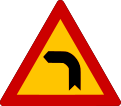 |
Κ-1α | Dangerous left turn | ΦΕΚ Β' 676/74 | ||
 |
Κ-1δ | Dangerous right turn | ΦΕΚ Β' 676/74 | ||
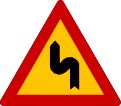 |
Κ-2δ | Dangerous two opposite or continuous turns, the first to the left | ΦΕΚ Β' 676/74 | ||
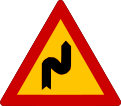 |
Κ-2δ | Dangerous two opposite or continuous turns, the first to the right | ΦΕΚ Β' 676/74 | ||
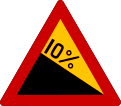 |
Κ-3 | Dangerous hill downwards (With slope as indicated on the sign) | ΦΕΚ Β' 676/74 | ||
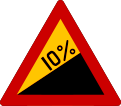 |
Κ-4 | Dangerous hill upwards (With slope as indicated on the sign) | ΦΕΚ Β' 676/74 | ||
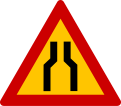 |
Κ-5 | Dangerous pavement narrowing on both sides | ΦΕΚ Β' 676/74 | ||
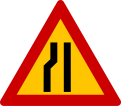 |
K-6α | Dangerous pavement narrowing on the left side | ΦΕΚ Β' 676/74 | ||
 |
K-6δ | Dangerous pavement narrowing on the right side | ΦΕΚ Β' 676/74 | ||
 |
Κ-7 | Moving bridge | ΦΕΚ Β' 676/74 | ||
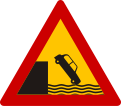 |
K-8 | The road leads to a dock or river bank | ΦΕΚ Β' 676/74 | ||
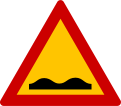 |
K-9 | Dangerous bumpy pavement in bad condition, with pits, etc. | ΦΕΚ Β' 676/74 | ||
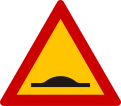 |
K-10 | Dangerous elevated pavement or steep curvy change of the lengthwise slope of the road | ΦΕΚ Β' 676/74 | ||
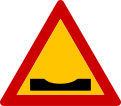 |
K-11 | Dangerous vertical gutter or steep hollow change of the lengthwise slope of the road | ΦΕΚ Β' 676/74 | ||
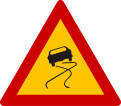 |
K-12 | Slippery pavement | ΦΕΚ Β' 676/74 | ||
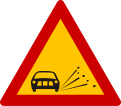 |
K-13 | Dangerous gravel ejection (loose chippings) | ΦΕΚ Β' 676/74 | ||
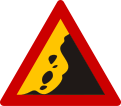 |
K-14 | Danger of falling rocks and their presence in the pavement | ΦΕΚ Β' 676/74 | ||
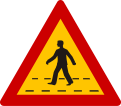 |
K-15 | Danger due to pedestrian crossing | ΦΕΚ Β' 676/74 | ||
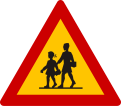 |
K-16 | Danger due to often children traffic (schools, stadiums, etc.) | ΦΕΚ Β' 676/74 | ||
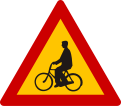 |
K-17 | Danger due to often entrance of cyclists, or cyclist crossing | ΦΕΚ Β' 676/74 | ||
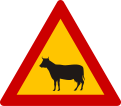 |
K-18 | Danger of domesticated animal crossing | ΦΕΚ Β' 676/74 | ||
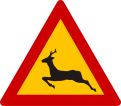 |
K-19 | Danger of wild animal crossing | ΦΕΚ Β' 676/74 | ||
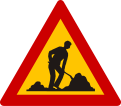 |
K-20 | Danger due to performed roadworks | ΦΕΚ Β' 676/74 | ||
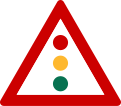 |
K-21 | Attention, intersection or position where traffic is regulated by three-colored traffic lights. | ΦΕΚ Β' 676/74 | ||
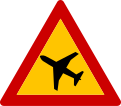 |
K-22 | Danger due to low flights of taking-off or landing aircraft | ΦΕΚ Β' 676/74 | ||
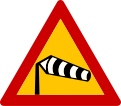 |
K-23α | Danger due to often strong wind (As the direction of the windsock shows) | ΦΕΚ Β' 676/74 | ||
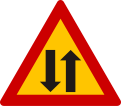 |
K-24 | Αdvance notice of a two-way traffic | ΦΕΚ Β' 676/74 | This sign means imminent entrance from a one-way road or part of a road that includes two decks separated by direction by a median strip, in a part of a road with traffic on the same pavement in both directions, temporarily or permanently. | |
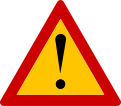 |
K-25 | Attention, other dangers (not indicated on former signs) | ΦΕΚ Β' 676/74 | ||
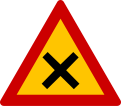 |
K-26 | Attention, junction where the priority from right is valid | ΦΕΚ Β' 676/74 | ||
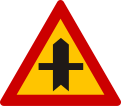 |
K-27 | 4-way intersection, with a road, on which drivers have to give priority | ΦΕΚ Β' 676/74 | ||
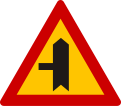 |
K-28α | 3-way intersection with a verctical road on the left, on which drivers have to give priority | ΦΕΚ Β' 676/74 | ||
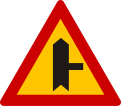 |
K-28δ | 3-way intersection with a verctical road on the right, on which drivers have to give priority | ΦΕΚ Β' 676/74 | ||
 |
K-29α | 3-way intersection with a obligue road on the left, on which drivers have to give priority | ΦΕΚ Β' 676/74 | ||
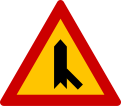 |
K-29δ | 3-way intersection with a obligue road on the left, on which drivers have to give priority | ΦΕΚ Β' 676/74 | ||
 |
K-30 | Approach to a circular mandatory route | ΦΕΚ Β' 676/74 | ||
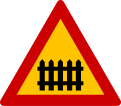 |
K-31 | Danger due to railway level crossing with moving barriers or tram crossing | ΦΕΚ Β' 676/74 | The "or tram crossing" phrase, was added in 2004, with ΦΕΚ Α’137/22-7-2004, due to the Athens Tram opening. | |
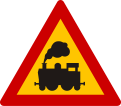 |
K-32 | Danger due to railway level crossing without moving barriers | ΦΕΚ Β' 676/74 | ||
 |
K-33, K- 34, K-35 | Additional repeative signs at acesses of railway level crossings or moving bridges, which indicate approach at them. | ΦΕΚ Β' 676/74 | ||
 |
K-36 | Danger due to immediate vicinity of a railway level crossing, without moving barriers, of single railway track or a tramway crossing | ΦΕΚ Β' 676/74 | The "or tram crossing" phrase, was added in 2004, with ΦΕΚ Α’137/22-7-2004, due to the Athens Tram opening. | |
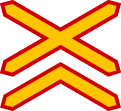 |
K-37 | Danger due to immediate vicinity of a railway level crossing, without moving barriers, of dual or multiple railway track or a tramway crossing | ΦΕΚ Β' 676/74 | The "or tram crossing" phrase, was added in 2004, with ΦΕΚ Α’137/22-7-2004, due to the Athens Tram opening. | |
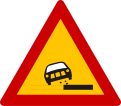 |
K-38α | Dangerous soft verges on the left | ΦΕΚ 182/Α/25-11-1992 | ||
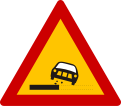 |
K-38δ | Dangerous soft verges on the right | ΦΕΚ 182/Α/25-11-1992 | ||
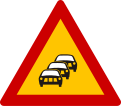 |
K-39 | Often traffic jam | ΦΕΚ 182/Α/25-11-1992 | ||
 |
K-40 | Tunnel | ΦΕΚ 182/Α/25-11-1992 | ||
 |
Κ-41 | Danger due to tram level crossing without moving barriers | ΦΕΚ Α’137/22-7-2004 | ||
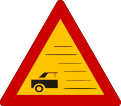 |
K-42 | Danger due to fog | ΦΕΚ Α’22/29-1-2014 | ||
 |
Κ-43 | Danger due to pararell pedestrian and cyclist crossings | ΦΕΚ Α’59/30-3-2018 | [11] | |
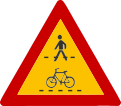 |
Κ-44 | Danger due to common pedestrian and cyclist crossings | ΦΕΚ Α’59/30-3-2018 | [11] |
Regulatory signs[17]
Prohibitory signs are round with white backgrounds and red borders.
- Prohibitory signs
 Give Way. This sign means that at the junction where it's placed, the drivers must give priority to the vehicles that move to the other road
Give Way. This sign means that at the junction where it's placed, the drivers must give priority to the vehicles that move to the other road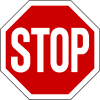 Stop. 1) This sign, when it's placed before a junction, means the mandatory stopping of the vehicle before entering the junction and the prioritization of the vehicles moving on the road to which it is approaching. (2) When placed to points other than a junction, means a mandatory stopping of the vehicle in the position of the sign and not start until the driver is sure that they can do so without risk.
Stop. 1) This sign, when it's placed before a junction, means the mandatory stopping of the vehicle before entering the junction and the prioritization of the vehicles moving on the road to which it is approaching. (2) When placed to points other than a junction, means a mandatory stopping of the vehicle in the position of the sign and not start until the driver is sure that they can do so without risk.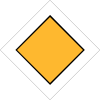 Priority road
Priority road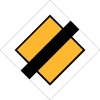 End of Priority road
End of Priority road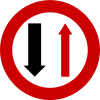 Priority for oncoming vehicles, because road narrows
Priority for oncoming vehicles, because road narrows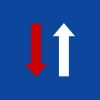 Priority over oncoming vehicles (Because road narrows)
Priority over oncoming vehicles (Because road narrows) No entry to all vehicles
No entry to all vehicles Road closed to all vehicles in both directions
Road closed to all vehicles in both directions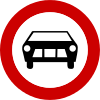 No motor vehicles except for motorcycles with two wheels.
No motor vehicles except for motorcycles with two wheels. No motorcycles
No motorcycles No bicycles
No bicycles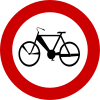 No mopeds
No mopeds No lorries. The number of tons, either in white on the vehicle or on an additional sign placed under the pictured one, means that the prohibition applies only if the maximum permissible weight of the vehicle or the combination of vehicles exceeds this number
No lorries. The number of tons, either in white on the vehicle or on an additional sign placed under the pictured one, means that the prohibition applies only if the maximum permissible weight of the vehicle or the combination of vehicles exceeds this number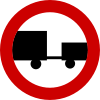 No motor vehicle pulling trailer, other than a semi-trailer or trailer with only one axle. The number of tons, either white in the trailer or on an additional sign, which is placed under the pictured, means that the prohibition applies only if the maximum authorized weight of the trailer exceeds this number.
No motor vehicle pulling trailer, other than a semi-trailer or trailer with only one axle. The number of tons, either white in the trailer or on an additional sign, which is placed under the pictured, means that the prohibition applies only if the maximum authorized weight of the trailer exceeds this number.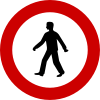 No pedestrians
No pedestrians No animal-drawn vehicles
No animal-drawn vehicles No handcarts
No handcarts No farm machinery
No farm machinery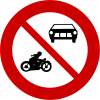 No motor vehicles
No motor vehicles No specific vehicles (eg motor and animal-drawn vehicles)
No specific vehicles (eg motor and animal-drawn vehicles) No vehicles with overall width exceeding (eg 2 meters).
No vehicles with overall width exceeding (eg 2 meters). No vehicles with overall height exceeding (eg 3,5 meters)
No vehicles with overall height exceeding (eg 3,5 meters) No vehicles with overall weight exceeding (eg 5 tons)
No vehicles with overall weight exceeding (eg 5 tons) No vehicles with overall weight exceeding (eg 2 tons) in one axle.
No vehicles with overall weight exceeding (eg 2 tons) in one axle. No vehicles with overall length exceeding (eg 10 meters).
No vehicles with overall length exceeding (eg 10 meters).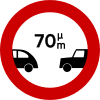 No driving with distance less than (eg 70) meters from two vehicles
No driving with distance less than (eg 70) meters from two vehicles No left turn
No left turn No right turn
No right turn No U-turns (180 degree turn)
No U-turns (180 degree turn) No overtaking by motor vehicles except motorcycles with two wheels
No overtaking by motor vehicles except motorcycles with two wheels No overtaking by lorries
No overtaking by lorries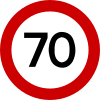 The maximum speed is limited to the indicated number (e.g., 70 km) per hour.The number of tons, on an additional sign, which is placed under the pictured, means that the speed limit applies only to vehicles with a total weight exceeding this number.
The maximum speed is limited to the indicated number (e.g., 70 km) per hour.The number of tons, on an additional sign, which is placed under the pictured, means that the speed limit applies only to vehicles with a total weight exceeding this number.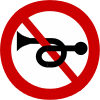 No horn (Except for avoiding an accident)
No horn (Except for avoiding an accident)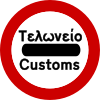 Passing without stopping prohibited at customs
Passing without stopping prohibited at customs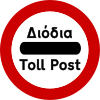 Passing without stopping prohibited at toll post
Passing without stopping prohibited at toll post End of all local prohibitions which have been imposed by prohibitory signs on moving vehicles
End of all local prohibitions which have been imposed by prohibitory signs on moving vehicles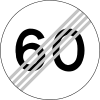 End of speed limit which have been imposed by a prohibitory sign (eg 60 km/h)
End of speed limit which have been imposed by a prohibitory sign (eg 60 km/h)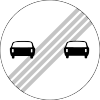 End of overtaking restriction which have been imposed by a prohibitory sign.
End of overtaking restriction which have been imposed by a prohibitory sign. No parking
No parking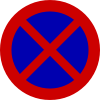 No stopping and parking, unless otherwise specified by an additional sign, etc. The prohibitions on these signs apply from the position of the signs to the next meeting point with a road and on the side of the pavement in which they are placed
No stopping and parking, unless otherwise specified by an additional sign, etc. The prohibitions on these signs apply from the position of the signs to the next meeting point with a road and on the side of the pavement in which they are placed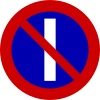 Alternative parking (prohibited on the sign's side on odd months of year)
Alternative parking (prohibited on the sign's side on odd months of year)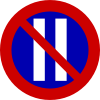 Alternative parking (prohibited on the sign's side on the even months of year)
Alternative parking (prohibited on the sign's side on the even months of year)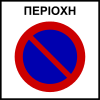 No parking zone (limited-time parking).
No parking zone (limited-time parking).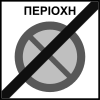 End of no parking zone
End of no parking zone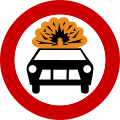 No vehicles carrying over a certain quantity of explosives or flammable goods
No vehicles carrying over a certain quantity of explosives or flammable goods No vehicles carrying over a certain quantity of goods which could pollute water
No vehicles carrying over a certain quantity of goods which could pollute water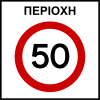 Highest speed area
Highest speed area End of highest speed limit zone (eg 50 km/h)
End of highest speed limit zone (eg 50 km/h)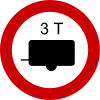 No trailers with weight exceeding (eg 3 tons)
No trailers with weight exceeding (eg 3 tons)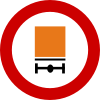 No vehicles carrying dangerous goods
No vehicles carrying dangerous goods Direction to be followed. Left only
Direction to be followed. Left only Direction to be followed. Right only
Direction to be followed. Right only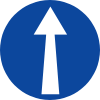 Direction to be followed. Forward only
Direction to be followed. Forward only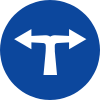 Direction to be followed. Turn left or right.
Direction to be followed. Turn left or right. Direction to be followed. Turn left
Direction to be followed. Turn left Direction to be followed. Turn right
Direction to be followed. Turn right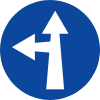 Direction to be followed. Turn left or continue straight ahead.
Direction to be followed. Turn left or continue straight ahead. Direction to be followed. Turn right or continue straight ahead.
Direction to be followed. Turn right or continue straight ahead. Pass this side. Either side
Pass this side. Either side Pass this side. Left
Pass this side. Left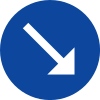 Pass this side. Right
Pass this side. Right Roundabout
Roundabout Track for cycles and mopeds
Track for cycles and mopeds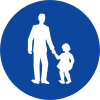 Footpath
Footpath Bridleway
Bridleway Snow chains compulsory
Snow chains compulsory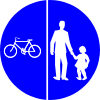 Compulsory track for pedestrians, cyclists and moped drivers. Dual track
Compulsory track for pedestrians, cyclists and moped drivers. Dual track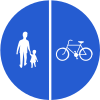 Compulsory track for pedestrians, cyclists and moped drivers. Dual track
Compulsory track for pedestrians, cyclists and moped drivers. Dual track Compulsory track for pedestrians, cyclists and moped drivers.
Compulsory track for pedestrians, cyclists and moped drivers. Beginning of lane reserved for scheduled buses etc.
Beginning of lane reserved for scheduled buses etc.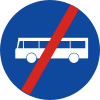 End lane reserved for scheduled buses etc.
End lane reserved for scheduled buses etc.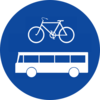 Reserved lane for buses, trolleybuses and bicycles
Reserved lane for buses, trolleybuses and bicycles End of reserved lane for buses, trolleybuses and bicycles
End of reserved lane for buses, trolleybuses and bicycles Controlled Parking
Controlled Parking Parking for TAXIs
Parking for TAXIs Parking for disabled (Special license required)
Parking for disabled (Special license required).png) Parking for specific disablet person (Special license and registration number required)
Parking for specific disablet person (Special license and registration number required) Direction to be followed for vehicles carrying dangerous goods. Turn left
Direction to be followed for vehicles carrying dangerous goods. Turn left Direction to be followed for vehicles carrying dangerous goods. Turn right
Direction to be followed for vehicles carrying dangerous goods. Turn right Direction to be followed for vehicles carrying dangerous goods. Turn left
Direction to be followed for vehicles carrying dangerous goods. Turn left Direction to be followed for vehicles carrying dangerous goods. Turn right
Direction to be followed for vehicles carrying dangerous goods. Turn right Water protection area
Water protection area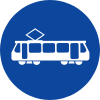 Beginning of lane reserved for trams
Beginning of lane reserved for trams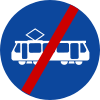 End lane reserved for trams
End lane reserved for trams
Informatory signs
- Informatory signs
 E-road numbering
E-road numbering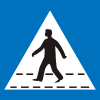 Pedestrian crossing
Pedestrian crossing Hospital
Hospital One-way street ahead
One-way street ahead.svg.png) One-way street
One-way street Dead end ahead on 90 degrees roads
Dead end ahead on 90 degrees roads Dead end ahead on non-90 degrees roads
Dead end ahead on non-90 degrees roads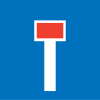 Dead end
Dead end Alternative direction
Alternative direction
 Expressway
Expressway End of expressway
End of expressway Motorway
Motorway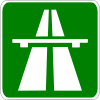 Motorway (alternative)
Motorway (alternative) End of motorway
End of motorway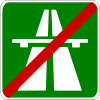 End of motorway (alternative)
End of motorway (alternative) First aid
First aid Workshop
Workshop Telephone
Telephone Petrol station
Petrol station Hotel
Hotel Restaurant
Restaurant Refreshments
Refreshments Picnic site
Picnic site Hiking trail
Hiking trail Caravan site
Caravan site Camping site
Camping site Youth hostel
Youth hostel Information
Information Bathing
Bathing Toilet
Toilet Radio station for road and traffic information
Radio station for road and traffic information Built-up area
Built-up area End of built-up area
End of built-up area Disabled persons
Disabled persons.svg.png) Sharp bend, Right (alternative)
Sharp bend, Right (alternative).svg.png) Sharp bend, Left (alternative)
Sharp bend, Left (alternative) Sharp bend, Right
Sharp bend, Right Sharp bend, Left
Sharp bend, Left Motorway numbering
Motorway numbering National road numbering (used on motorway signs only)
National road numbering (used on motorway signs only) National road numbering (used on every road type but motorways)
National road numbering (used on every road type but motorways) Direction sign in Expressway intersections with two directions
Direction sign in Expressway intersections with two directions Direction sign in Expressway intersections with one direction
Direction sign in Expressway intersections with one direction Direction sign on usual roads
Direction sign on usual roads Direction sign on roads of local road network
Direction sign on roads of local road network Direction sign on tourist roads
Direction sign on tourist roads Direction sign on tourist roads
Direction sign on tourist roads Direction sign
Direction sign Direction sign
Direction sign Direction sign to Airport
Direction sign to Airport Advance direction sign, diagrammatic type
Advance direction sign, diagrammatic type
Rare, special or unofficial signs
 Acropolis museum direction sign
Acropolis museum direction sign Bilingual direction sign without km
Bilingual direction sign without km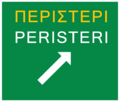 Motorway exit
Motorway exit Direction to airport
Direction to airport Sign used when entering Greece from other country
Sign used when entering Greece from other country No parking
No parking Pedestrian cross direction sign
Pedestrian cross direction sign Direction arrow
Direction arrow Continuous pedestrian crossings
Continuous pedestrian crossings Speed bump
Speed bump No lorries turning left
No lorries turning left No lorries turning right
No lorries turning right Lorries over 6 tones are prohibited to enter the road
Lorries over 6 tones are prohibited to enter the road Lorries and buses are prohibited to enter the road
Lorries and buses are prohibited to enter the road Buses are prohibited to enter the road
Buses are prohibited to enter the road Passing without stopping prohibited (control)
Passing without stopping prohibited (control) Regulatory sign of reserved lane for lorries
Regulatory sign of reserved lane for lorries Regulatory sign of reserved lane for cars
Regulatory sign of reserved lane for cars Other dangers (temporary)
Other dangers (temporary) Fog likely (Alternative)
Fog likely (Alternative)- No parking
Athens Bus Service signs
Bus Service road signs for prohibiting parking on bus route narrow turning points
 "No parking. Bus passing". Athens Urban Transport Servive (OASA) and Thermal Bus Company (ETHEL) road sign.
"No parking. Bus passing". Athens Urban Transport Servive (OASA) and Thermal Bus Company (ETHEL) road sign. "No parking. Bus passing". Athens Urban Transport Servive (OASA) and Thermal Bus Company (ETHEL) road sign.
"No parking. Bus passing". Athens Urban Transport Servive (OASA) and Thermal Bus Company (ETHEL) road sign. "Bus passing. Illegally parked vehicles will be towed". Athens Urban Transport Servive (OASA) and Thermal Bus Company (ETHEL) new road sign.
"Bus passing. Illegally parked vehicles will be towed". Athens Urban Transport Servive (OASA) and Thermal Bus Company (ETHEL) new road sign.
Bus route guidance road signs
 Left arrow - Athens Urban Transport Servive (OASA) guidance sign (with route label).
Left arrow - Athens Urban Transport Servive (OASA) guidance sign (with route label). Forward arrow - Athens Urban Transoport Servive (OASA) guidance (without route label).
Forward arrow - Athens Urban Transoport Servive (OASA) guidance (without route label). Right arrow - Athens Urban Transoport Servive (OASA) guidance (without route label).
Right arrow - Athens Urban Transoport Servive (OASA) guidance (without route label).
Bus stop signs
 Old Athens bus stop sign (OASA-ETHEL) circa 1994-2005.
Old Athens bus stop sign (OASA-ETHEL) circa 1994-2005. Recent Athens bus stop sign (OASA-ETHEL) circa 2005-2015.
Recent Athens bus stop sign (OASA-ETHEL) circa 2005-2015. Most recent Athens bus stop sign (OASA-OSY) since 2015 circa.
Most recent Athens bus stop sign (OASA-OSY) since 2015 circa.
Retired signs (no longer in use)
Below, signs are withdrawn or replaced with new diagrams of the same meaning.
Other marks[20]
 Stopping is obligatory (Stop)
Stopping is obligatory (Stop) Stopping
Stopping Parking
Parking Course like arrows
Course like arrows Course like arrows
Course like arrows Progressive load indications
Progressive load indications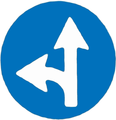 Course like arrows
Course like arrows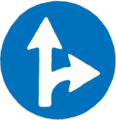 Course like arrows
Course like arrows Course like arrow
Course like arrow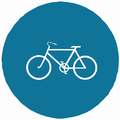 Mandatory bicycle space
Mandatory bicycle space Traffic area exclusively by pedestrians
Traffic area exclusively by pedestrians Obligatory run of the depicted vehicle
Obligatory run of the depicted vehicle
Useful indications[20]
 Parking lot
Parking lot Gasoline or diesel oil
Gasoline or diesel oil Phone
Phone Attention to the forest. The Greek text says "Fire hazard"
Attention to the forest. The Greek text says "Fire hazard" Parking lot for caravans
Parking lot for caravans Hospital
Hospital First aid
First aid Workshop
Workshop Camping site
Camping site Special directional & distance sign for the vehicle shown in white space
Special directional & distance sign for the vehicle shown in white space
Warning signs[21][22]
 Pavement with abnormalities
Pavement with abnormalities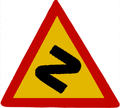 Dangerous continuous curves
Dangerous continuous curves Right curne
Right curne Left curve
Left curve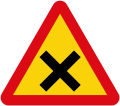 Non-priority cross-junction
Non-priority cross-junction Cross-junction with moving priority as the arrow
Cross-junction with moving priority as the arrow Cross-junction with moving priority as the arrow
Cross-junction with moving priority as the arrow Narrow road
Narrow road Slope (Αmount indicted)
Slope (Αmount indicted)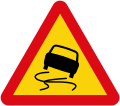 Sliperry road
Sliperry road Swing bridge
Swing bridge Danger
Danger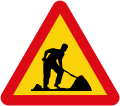 Works on the road
Works on the road School
School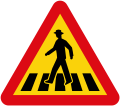 Pedestrian crossing
Pedestrian crossing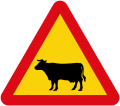 Animal passage
Animal passage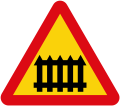 Level crossing is guarded
Level crossing is guarded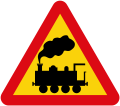 Level crossing is unguarded
Level crossing is unguarded Alert for unguarded level crossing
Alert for unguarded level crossing Alert for level crossing distance
Alert for level crossing distance Alert for level crossing distance
Alert for level crossing distance Alert for level crossing distance (These signs were placed under the signs for the level crossings)
Alert for level crossing distance (These signs were placed under the signs for the level crossings)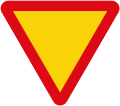 Approach to a road where the vehicles on it have priority. (Yield)
Approach to a road where the vehicles on it have priority. (Yield)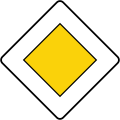 Priority road sign
Priority road sign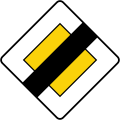 Priority expiration sign
Priority expiration sign
Area indications[22]
 The numbers denoted the mileage
The numbers denoted the mileage The arrow indicated the direction
The arrow indicated the direction Bypass with underpass
Bypass with underpass Toponym
Toponym
Temporarily retained signs (1974-1978).[23]
 Pd-1 - Beware, other hazards with the K-25's declaring significance
Pd-1 - Beware, other hazards with the K-25's declaring significance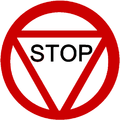 Pd-2 - Mandatory stopping of the route (STOP) with the expressive importance of P-2.
Pd-2 - Mandatory stopping of the route (STOP) with the expressive importance of P-2. Pd - 3 No motor vehicles with the expressive meaning of P-19.
Pd - 3 No motor vehicles with the expressive meaning of P-19.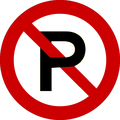 Pd - 4 No parking with the expressive importance of R-39
Pd - 4 No parking with the expressive importance of R-39 Pd-5 Parking is prohibited on the side of the sign during the odd months with the prominent significance of P-41
Pd-5 Parking is prohibited on the side of the sign during the odd months with the prominent significance of P-41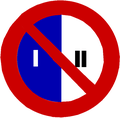 Pd- 6 Parking is prohibited on the side of the sign, in the even months with the declarative significance of the P-42
Pd- 6 Parking is prohibited on the side of the sign, in the even months with the declarative significance of the P-42
Katharevousa and Polytonic
Regulatory[24]
 No passing without stopping before the customs - By the word "Τελωνεῖον"
No passing without stopping before the customs - By the word "Τελωνεῖον"
Informatory[25]
 Expressway Warning Signal with Mileage Distances - By the word "Ἀσπρόπυργος"
Expressway Warning Signal with Mileage Distances - By the word "Ἀσπρόπυργος" Common road Warning Signal with Mileage Distances - By the word "Ἠράκλειον" and "Ἀθήναι"
Common road Warning Signal with Mileage Distances - By the word "Ἠράκλειον" and "Ἀθήναι" Direction of a toponym, arrow shape - By the word "Τρίλοφον"
Direction of a toponym, arrow shape - By the word "Τρίλοφον" Direction of a toponym, arrow shape - By the word "Πειραιεύς"
Direction of a toponym, arrow shape - By the word "Πειραιεύς" Direction of more toponym, arrow shape - With the words "'Ἀερολιμήν" and "Πειραιεύς"
Direction of more toponym, arrow shape - With the words "'Ἀερολιμήν" and "Πειραιεύς" Direction of a toponym, rectangular shape - By the word "Ἠράκλειον"
Direction of a toponym, rectangular shape - By the word "Ἠράκλειον" Airport Direction - By the word "Ἀθῆναι"
Airport Direction - By the word "Ἀθῆναι" Start of a residential area - By the word "Τρίπολις"
Start of a residential area - By the word "Τρίπολις" End of residential area - By the word "Τρίπολις"
End of residential area - By the word "Τρίπολις" Toponyms - "Ποταμός Εύρώτας"
Toponyms - "Ποταμός Εύρώτας" Tourist information - By the word "Πληροφορίαι"
Tourist information - By the word "Πληροφορίαι"
Old motorway signs with blue background[26]
 Motorway (Blue background)
Motorway (Blue background) End of motorway (Blue background)
End of motorway (Blue background)
References
- "Πρότυπα σήμανσης και εξοπλισμού οδών" (PDF). Ενημερωτικό δελτίου Τ.Ε.Ε. (Τεύχος 1980). 14 November 1997.
- "Πρότυπα σήμανσης και εξοπλισμού οδών" (PDF). Ενημερωτικό δελτίου Τ.Ε.Ε. (Τεύχος 1980). 14 November 1997.
- "Πριν τα αυτοκίνητα: Αυτός ήταν ο πρώτος ΚΟΚ της Ελλάδας". Μικροπράγματα (in Greek). 2018-08-31. Retrieved 2019-06-04.
- "Σήμανση οδών" (PDF).
- "ΕΛΠΑ - Ελληνική Λέσχη Αυτοκινήτου και Περιηγήσεων". 2014-07-07. Archived from the original on 2014-07-07. Retrieved 2019-09-17.
- "Σήμανση οδών" (PDF).
- "Σήματα ΚΟΚ". TestKOK.gr. Retrieved 2019-06-09.
- "ΚΟΚ On-line: Πινακίδες Αναγγελίας Κινδύνου | Glavopoulos Loss Adjusters Inc". Glavopoulos Loss Adjusters Inc. (in Greek). Retrieved 2018-10-03.
- Κώδικας Οδικής Κυκλοφορίας - Άρθρο 4. Glavopoulos Loss Adjusters Inc. (in Greek). 2016-12-15. Retrieved 2020-08-14.
- Πινακίδες αναγγελίας κινδύνου - Κατηγορίες Πινακίδων. ΖΑΦΕΙΡΟΠΟΥΛΟΣ ΧΡΗΣΤΟΣ Α.Ε. (in Greek). Retrieved 2020-08-14.
- DrD (2018-04-10). "Τροποποίηση του Κ.Ο.Κ. νέες πινακίδες κατακόρυφης σήμανσης". www.drivenews.gr (in Greek). Retrieved 2020-08-15.
- Πινακίδες Αναγγελίας Κινδύνου. Glavopoulos Loss Adjusters Inc. (in Greek). 2017-01-10. Retrieved 2020-08-15.
- "Πινακίδες Αναγγελίας Κινδύνου". www.astynomia.gr. Retrieved 2020-08-15.
- "ΠΙΝΑΚΙΔΕΣ ΑΝΑΓΓΕΛΙΑΣ ΚΙΝΔΥΝΟΥ – Σχολές Οδηγών Ίκαρος". www.sxolesodigonikaros.gr. Retrieved 2020-08-15.
- "All Greek road signs" (PDF).
- "Αναγγελίας Κινδύνου (Κ) - Γενικά - Giaseranis.gr | Σχολή Οδηγών". www.giaseranis.gr. Retrieved 2020-08-15.
- "ΚΟΚ On-line: Πινακίδες Ρυθμιστικές της Κυκλοφορίας | Glavopoulos Loss Adjusters Inc". Glavopoulos Loss Adjusters Inc. (in Greek). Retrieved 2018-11-21.
- Agenta "Έσπερος". 1965.
- Μάθε νά κυκλοφορῆς (PDF). ΑΘΗΝΑΙ: BP Greece, Υπουργείον Μεταφορών. 1962. p. 39.
- Μάθε νά κυκλοφορῆς (PDF). ΑΘΗΝΑΙ: BP Greece, Υπουργείον Μεταφορών. 1962. p. 89.
- Μάθε νά κυκλοφορῆς (PDF). ΑΘΗΝΑΙ: BP Hellas, Υπουργείον Συγκοινωνιών. 1963. p. 91.
- Μάθε νά κυκλοφορῆς (PDF). ΑΘΗΝΑΙ: BP Greece, Υπουργείον Μεταφορών. 1962. p. 93.
- ΦΕΚ 676. 1974. p. 5201.
- ΦΕΚ 676. 1974. p. 5193.
- ΦΕΚ 676. 1974. pp. 5195–5199.
- Ερώτηση 10, Φύλλο #8 από τα "Φύλλα ερωτήσεων διά τήν εξέτασιν υποψηφίων οδηγών αυτοκινήτων - μοτοσυκλετών και μοτοποδηλάτων". Υπουργείον Συγκοινωνιών, Γεν. Δ/νσις Μεταφορών, Εκτύπωσις: Οικονόμου. 1976.
- Hellenic Road Police
- testkok.gr
